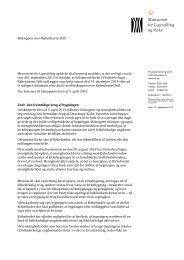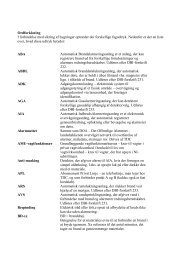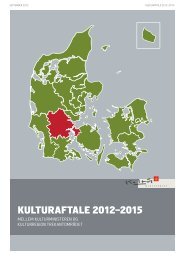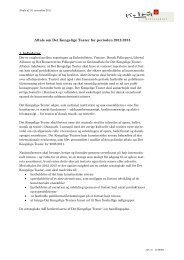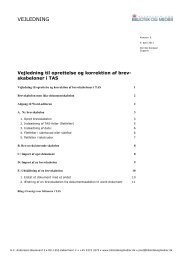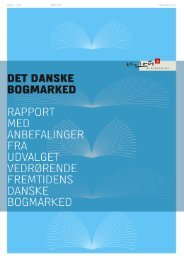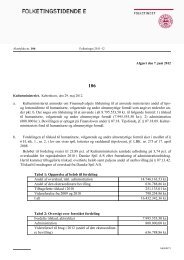Rock Festival Safety Table of contents
Rock Festival Safety Table of contents
Rock Festival Safety Table of contents
You also want an ePaper? Increase the reach of your titles
YUMPU automatically turns print PDFs into web optimized ePapers that Google loves.
As the responsibility for safety at festivals/concerts to a great extent remains with the promoter <strong>of</strong> the event, regardless<br />
<strong>of</strong> whether the safety risk factors stem from the performers on stage or the behaviour <strong>of</strong> other contracted parties,<br />
technical malfunction or other cause, placing contractual limitations on the risk behaviour <strong>of</strong> contracted parties —<br />
performers or otherwise — will be <strong>of</strong> immense significance.<br />
A detailed outline <strong>of</strong> planned activities and<br />
clear contractual limitations on the scope <strong>of</strong> performers and other parties to deviate from planned, agreed and approved<br />
safety provisions should therefore constitute an element <strong>of</strong> deliberations on safety provisions prior to a<br />
festival/concert.<br />
The police department in the area in which the festival/concert is being held will, against the background <strong>of</strong> the<br />
festival/concert promoter’s risk evaluation, determine whether the promoter’s safety provisions and state <strong>of</strong> readiness to<br />
respond to an emergency correspond to the promoter’s evaluation <strong>of</strong> pertinent risks, when a permit for an event is being<br />
considered.<br />
As most events <strong>of</strong> this kind are annual, recur-rent events this position, as a general rule and especially in the initial year,<br />
will be hampered by the fact that permission to hold a festival must be applied for and obtained before the details <strong>of</strong> its<br />
programme are known. General safety provisions and readiness to respond to an emergency will typically be the same<br />
year after year, while only significant changes with respect to an event or youth culture, or extraordinary constituents<br />
and consequently extraordinary risks, will demand the introduction <strong>of</strong> new safety provisions.<br />
GUIDELINES ON EVALUATING RISKS AND SAFETY<br />
The Working Group has established that the conditions which should constitute the point <strong>of</strong> departure for risk<br />
evaluations on the part <strong>of</strong> promoters and public authorities, alike, are manifold, complex and subject to constant change<br />
to an extent that demands solid and up-to-date information material.<br />
The Working Group has studied, to great avail, the most important international empirical publication on music<br />
festivals and concerts, namely, The British Event <strong>Safety</strong> Guide (also called PopCode), first published in 1993 and again<br />
in a revised edition in 1999 by the British Home Office and the Scottish Home Office. The Guide is a comprehensive<br />
outline <strong>of</strong> risk factors with parallel safety provisions for music festivals and similar events. The Guide came to fruition<br />
as a result <strong>of</strong> cooperation between the music industry and public authorities in the UK, where the music industry itself<br />
was the driving force.<br />
The Event <strong>Safety</strong> Guide contains many-sided advice and guidelines from which promoters can derive much practical<br />
benefit. The Guide’s target group is, primarily, promoters and the agencies responsible for safety at major music events.<br />
In the opinion <strong>of</strong> the Working Group funds must be made available, as soon as possible, to publish a Danish (preferably<br />
Scandinavian) parallel to this Guide.<br />
The Danish (Scandinavian) edition should, according to the Working Group, contain more detailed chapters on the<br />
following themes, which are not dealt with exhaustively in the British edition:<br />
1) Crowd management<br />
2) Chain <strong>of</strong> command and decision-making competence<br />
3) Communications with the public<br />
The Danish (Scandinavian) guide should con-stitute the point <strong>of</strong> departure for the evaluation <strong>of</strong> concrete risks<br />
conducted by individual promoters and his/her safety provisions planning.<br />
OVERALL COORDINATION OF<br />
RESPONSIBILITY OF ALL INVOLVED PUBLIC AGENCIES<br />
Today, the police are the competent body for granting permits for festivals/concerts and setting conditions with respect<br />
to the observance <strong>of</strong> law and order during a music event. In the event <strong>of</strong> a major accident, at which different agencies<br />
cooperate on rescue operations, the police act as the coordinating agency. In the opinion <strong>of</strong> the Working Group, there is<br />
no reason to change these regulations.<br />
ESTABLISHING AN INTERNAL UNIT WITHIN THE POLICE WITH<br />
SPECIAL KNOWLEDGE OF CROWD MANAGEMENT<br />
<strong>Festival</strong>s/concerts in Denmark, other Scandinavian countries and other venues around Europe have undergone pr<strong>of</strong>ound<br />
change in recent years, from small affairs, running over a few days, to medium-sized or huge events attracting more<br />
than 100,000 people, including fans and helpers, <strong>of</strong>ten lasting more than a week, in the sense that festival goers arrive at<br />
the festival site several days in advance to secure a good camping spot and to “warm up”. Youth and music culture is<br />
undergoing constant and marked change. And there is no indication, at present, that this development will cease.<br />
21



